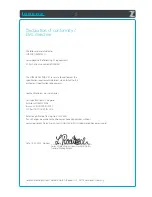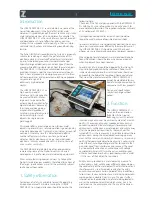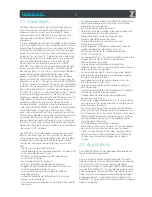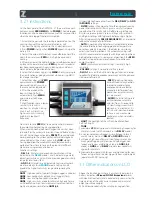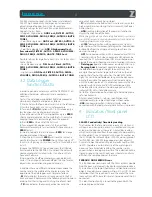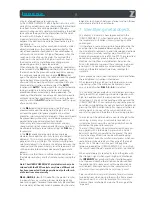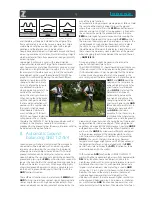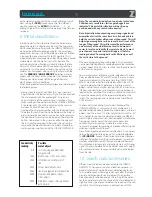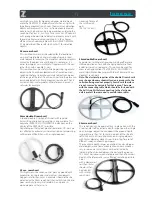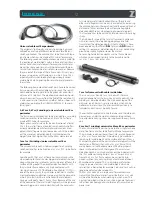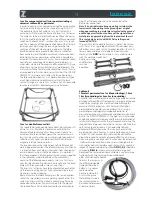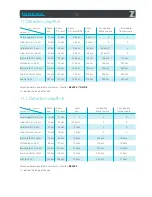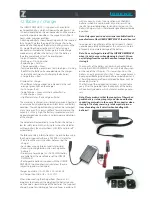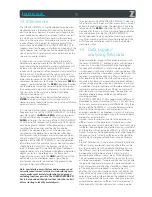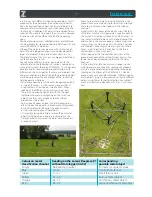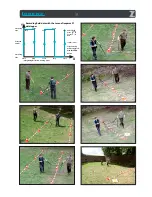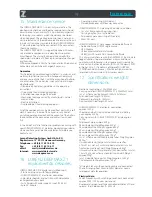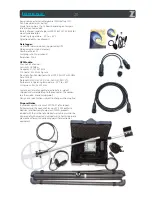
results even with difficult surrounding conditions. Faults
produced by the operator or the environmental condi-
tions like overload signals from nearby metal objects for
example will be immediately seen when comparing the
six channels. In addition GPS data is also recorded from a
supplied GPS module to support the user with a compass
function or to find the different fields after recording
again.
For the professional users additional Hard- and Software
will be available for storing positioning data from GPS and
several DEEPMAX Z1 detectors.
Although the detector can be used with smaller search
heads the data logger function is mainly developed for
larger metal objects being at least 6cm x 6cm in size.
Therefore frames of 1m x 1m or even bigger should be in
use to achieve best results.
To analyze the different pictures generated with the
software refer to the following instructions. Compared to
many other systems the Lorenz DEEPMAX Z1 will not only
generate one or several graphic representations with
different sensitivity ranges for the same metal objects but
also gives additional information on the probable kind of
metal being located. The advantages of the six channel
data logger are as follows:
• False or overload data will be easily recognized on one
or two of the maps. At the same time you will find
useful data on at least one or two channels. When
looking at the different maps/pictures select only
these with no ground signals or with the stronger
indications to avoid investigating on the small junk
objects like foils, nails, magnetic soils or littered
ground near the surface.
• Some signals appear on one scan and disappear on
others to give the operator more advanced informtion
on the kind of metal (decay of the eddy currents)
or the surrounding ground conditions.
• It is possible to separate two or more different metal
objects which give only one large indication in the
Delay channels but two on the metal classification or
Ground channels.
• Some ferrous metal objects lying horizontally in the
ground will cause a special triple signal with two high
and a low indication when looking at the Ground
channels.
• Signals with a fast decay of the eddy current like foils,
thin plates small nails will generate a negative peak in
the vertical Z direction in Ground 1 and 2 channels, At
the same time Metal objects with a long decay of the
eddy currents like massive copper, bronze, aluminum or
silver will cause a positive peak in Z direction. Ferrous
metal objects will only give weaker signals and there
fore a small indication in Z direction (in the three
dimensional surface maps only)
• When looking at the Ground channels most of the
ground and some of the smaller ferrous items will no
longer be displayed comparing them to the Delay
channels.
• On the metal classification pictures stronger signals
which generate a conductivity reading will produce
mainly a single color dot corresponding to the delay
reading on the display of the DEEPMAX Z1. Neutral
ground will cause a purple indication. Different nearby
metal objects lying in close proximity will give different
colors in most cases for better selection. See table of
metal classification indications with a 1m x 1m frame
coil:
13. Interference
The LORENZ DEEPMAX Z1 was developed to ignore most
electromagnetic interference EMI received by the search
coil. In some cases however there are very strong interfer-
ences produced by power lines, railroad tracks or transmit-
ters which are very difficult to suppress with electronic
circuitry as they are many times more intense than a signal
received from a metal object for example. Several filter
circuits have been added to the LORENZ DEEPMAX Z1 to
suppress most low frequency interference. Especially in the
near of power lines interference can be noticed with false
signals or rhythmic signals which cause indications on the
screen or an audio response.
In urban areas, near transmitters or when other metal
detectors are working close to the DEEPMAX Z1 interfer-
ences could also be expected. In general interference will
increase with the size of the search coil. Interference
received with large coils is often accepted in respect of the
high sensitivity still offered with those particular coils. In
some cases interference can be so intense that it is simply
impossible to work with the DEEPMAX Z1. Therefore it will
sometimes be necessary to change the frequency
FREQ
to
suppress some interference. The
FREQ
Frequency function
can therefore be turned to a lower or higher setting, until
the audio sound is clear and without any rhythmic pulses.
The sensitivity or the metal classification will not be
affected when doing this.
For further reduction of any pulsed interferences put
FILTER
to a higher setting but this will also result in a
slower response speed which makes only sense with frame
coils but not with smaller coils.
If it is not possible to reduce interference by changing the
frequency and filter of the LORENZ DEEPMAX Z1 it is either
possible to put the
AUDIO
or
SENS
Sensitivity to a lower
setting until the noise disappears. When setting the
AUDIO
setting to - the sensitivity of the LORENZ DEEPMAX
Z1 will be slightly reduced, but the amount of false signals
will also be greatly reduced. When connecting a smaller
search coil the amount of interference can also be
reduced. The compensated 1m x 2m frame mounted
search coil or the double frame coil do not suffer from
interferences, false indications are simply reduced when
using these coils. This will always guarantee a very stable
operation of the LORENZ DEEPMAX Z1. For the detection
of smaller objects the available 1m x1m double frame coil
should be rather used than the compensated 2m x 1m
(eight 8 shaped) coil. This specially designed frame coil is
capable to eliminate interference while offering detection
depths similar to a single loop 1m x 1m frame coil.
Especially when working in the
GND
mode this coil is the
best choice, as the electronics need a signal free of
interference to be able to cancel out the ground and to
distinguish between different metals.
Note: Low interference with clear audio response and
correctly tuned (zeroed) electronics is absolutely neces-
sary to make exact metal classifications and ground
excluding functions possible. The LORENZ DEEPMAX Z1
has to be tuned and the right coil has to be chosen first
before starting to identify metal objects.
The electronics unit of the LORENZ DEEPMAX Z1 does not
suffer from any drift in general. That means only in case of
extreme temperature changes the electronics have to be
retuned with the
ZERO
button shortly. The same should
be done after the very first five minutes of operation since
many components inside the LORENZ DEEPMAX Z1
control box need to warm up to their working tempera-
ture. When working with small handheld search coils the
AUTO function can also be used to make the detector
work more stable.
14. Data Logger/
analyzing field data
To generate color, image, surface or contour maps with
the Lorenz DEEPMAX Z1, additional Hard- and Software is
necessary. A very sophisticated 6 channel data logger
function of the DEEPMAX Z1 metal detector will take
simultaneously six channels of data when you go over the
ground and stores the information into memory when this
function is selected (see chapter 3.2 for instructions).
After recording field data the Surfer Software easily and
accurately transforms the stored data into color, contour,
surface, image or vector maps on a computer in minutes.
An additional Scripter Software will therefore automatical-
ly generate twelve maps with each field. Six are two-di-
mensional and six three-dimensional. The operator can
therefore choose between different gridding and
mapping methods.
The LORENZ DEEPMAX Z1 Data Logger Hard/Software kit
developed by Lorenz Detecting Systems is first of all easy
to use, very accurately working and affordable. Only three
controls of the DEEPMAX Z1 will make data acquisition a
pleasure for both beginners and professionals like
engineers, geologists, archaeologists, scientists and many
more. The users will investigate mainly for waste disposal,
meteorites, or lost aircrafts.
No non- sense functions will confuse the operator. Six
different maps will be generated simultaneously when
covering the ground with multiple tracks. Each scan/ map
is different depending on the electronic analysis method
and therefore will not only give different sensitivity ranges
but can be the key to the probable kind of metal buried in
the ground. There is clearly a difference in the signature
metal objects and ground conditions will give for exam-
ple.
Areas of disturbances in the scans will directly lead to the
different metals or ground signals and therefore can be
classified in some ways. The operator therefore can use
the different scans to his advantage in order to choose
between the metal objects of most interest only by
comparing the different scans/ maps. Three delay chan-
nels will produce maps with different sensitivity to small
and large metal objects. Two ground channels will enable
the operator to generate maps with no ground response
but Z dimensions and directions for different decay curves
of the eddy currents produced in a metal object. In
addition the metal classification channel will display the
delay of the eddy currents of each signal with a specific
color to give further information on the probable kind of
metal in the ground. No matter how strong the ground is
mineralized or how many different metals are located in
close proximity, this new device will ensure very good
O R E N Z
16
Содержание DEEPMAX Z1
Страница 1: ...O R E N Z OPERATING MANUAL...

